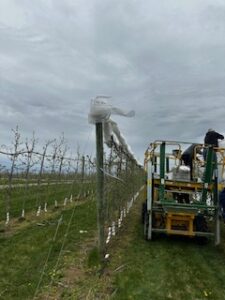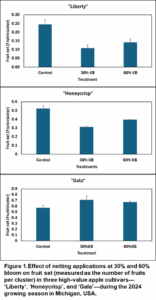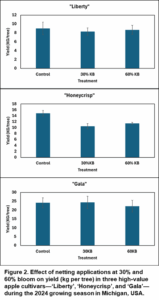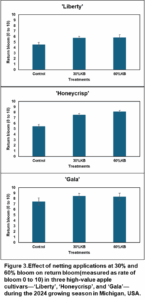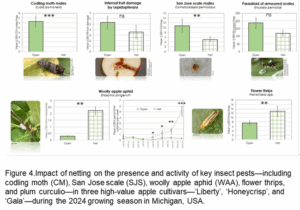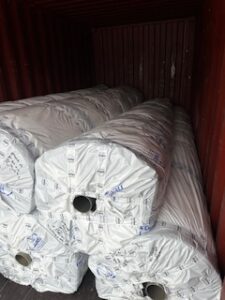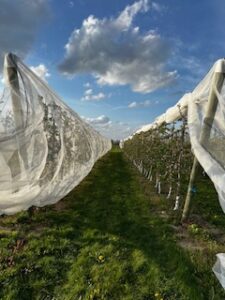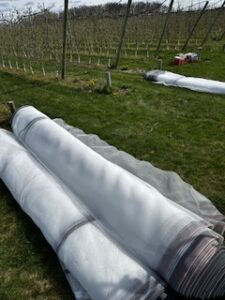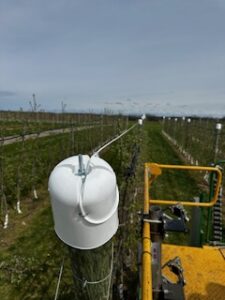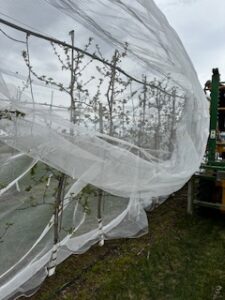Progress report for LNC23-487
Project Information
Achieving consistent crop loads of high-quality fruit is extraordinarily challenging. Apple producers rely heavily on thinning compounds to reduce their fruit set and meet their target crop level. Both under- and over-thinning have serious economic consequences. Furthermore, organic apple producers have very few labeled thinning compounds at their disposal; thus, expensive labor costs associated with hand thinning are required. There are numerous benefits associated with over-the-row netting systems, including but not limited to, exclusion of pests, hail protection, sunburn control, improved water use efficiency, and reduced chemical use. For these reasons, many US apple producers have recently adopted netting systems; however, we have recently demonstrated that nets can also be used to solve critical fruit set and crop load management issues. Achieving ‘target’ crop load via nets would substantially mitigate or eliminate cost-prohibitive and/or chemically-intensive thinning methods required to abscise superfluous fruit. Providing Midwestern apple producers with an alternative crop load management tool may also facilitate a transition to more sustainable, organic production given the dearth of options for thinning fruit. More broadly, netting can decrease chemical and insecticide applications and increase grower profitability for conventional and organic producers alike.
Over the past 5 years, we have demonstrated that netting can effectively produce commercial crops of apples in modern, high-density, tall spindle apple trees without the need for supplemental thinning on both commercial and University farms. Over this timeframe, we have optimized the timing of net enclosure, based on the percentage of open king bloom, for the high-value cultivars ‘Gala’, ‘Honeycrisp’, ‘Fuji’, and ‘SweeTango’. Netting canopies from pink to full bloom produced a positive yield response and generated commercial crops of high-quality fruit. The next step toward stakeholder adoption is to scale-up experiments to assess the practical use of netting and demonstrate reduced insect pressure and horticultural/crop production benefits. We propose to optimize and demonstrate net use on a commercial scale in our proposal entitled, A Sustainable, Non-Chemical Thinning Method for US Midwestern Apple Producers: Novel Use of Anti-Hail, Insect-Exclusion Netting. To achieve this, we have engaged commercial famers to collaborate with a research team on the design and implementation of nets to reduce crop load on diverse farms (both geographically and in management). With our commercial partners, we expect to demonstrate the benefits of netting on insect/pest populations and profitability and communicate and disseminate these findings to stakeholder and scientific audiences in a variety of forums.
We intend to investigate the economic and environmental impacts of netting on Midwestern apple production, and to provide stakeholders with recommendations based on commercial-scale trials.
Producers will learn how to apply new production-system technologies to manage pests, hail and crop load and gain invaluable understanding of pollination processes and fruit set biology under controlled environment systems.
Growers will learn to use nets to manage fruit set and crop load, protect against biotic and abiotic stresses, reduce chemical and pesticide use, and increase their profitability. Organic producers will have an efficacious and reliable method at their disposal to reduce thinning pressure.
Over-the-row anti-hail, insect exclusion nets directly impact grower profitability. First, nets enhance crop productivity, yield security, fruit quality, and uniformity due to their ability to modify the microclimate. Key microclimate modifications reduce canopy temperatures and improve water use efficiency. Second, nets reduce crop loss by protecting fruit from environmental stress caused by excess temperatures and radiation, wind, and hail resulting in sunburn, fruit surface blemishes and partial or total crop destruction, respectively. Third, net usage (including regulation of fruit set) will reduce or eliminate costs and stress associated with thinning and insect pressure. Importantly, this effort seeks to expand organic production by overcoming multiple production challenges that currently preclude or severely restrict organic apple production in the Midwest. Despite these important benefits, the use of netting systems in orchards remains an expensive proposition; therefore, in order to return the investment of nets, growers need to maximize their use to solve multiple management challenges.
Over-the-row, anti-hail, insect exclusion nets provide an environmentally clean method to adjust fruit set and yield in addition to managing key insect pests of apple (codling moth, plum curculio, and brown marmorated stink bug). The potential for fewer insecticidal applications reduces environmental risks associated with drift and/or surface runoff and surface water contamination. Reduced risk of chemical toxicity to humans, fish, birds, and non-targeted plants enhances biodiversity and improves the quality of life of farmers and society, as a whole.
Cooperators
Research
We hypothesize that over-the-row anti-hail, insect-exclusion netting, when deployed at specific bloom phenologies (33% and 66% king bloom), will enhance sustainable apple production by improving fruit quality, optimizing crop load, and reducing pest pressure and chemical inputs, without negatively impacting vegetative growth or return bloom. We expect these benefits to be consistent across multiple cultivars and production systems in Michigan. Specifically, we anticipate that netted trees will exhibit improved fruit retention, reduced pre-harvest drop, and enhanced fruit quality (including color, firmness, and internal composition) at harvest and after storage. Netting is also expected to lower pest incidence (e.g., Brown Marmorated Stink Bug, Plum Curculio, Codling Moth) through physical exclusion, thereby reducing the need for insecticide applications and associated tractor use. Ultimately, we project that these improvements will lead to higher net returns per acre and support environmentally sustainable orchard management practices without compromising return bloom or inducing biennial bearing.
Experiment start date:
January 1, 2024
Experiment end date:
December 31, 2025
Plant Material:
Three high-value apple cultivars with different bearing tendencies will be identified in three disparate production regions of Michigan: two commercial orchards (Almar Orchards Organic, Flushing, MI & Schwallier's Country Basket, Sparta, MI) and MSU Clarksville Research Center (CRC). These two farmers have played an integral role in designing the experiment to fit their unique production needs and are hosting 2/3rd of the trials. At each trial site, the research team will evaluate the effects of nets on horticultural performance, crop production, and insect populations and pest pressure. This is an integrated and systematic approach that utilizes grower expertise within unique farming systems in collaboration with tree physiologists and tree fruit production researchers and entomologists.
Experimental design:
We will use randomized complete block designs with three treatments and five replicate rows per treatment comprising a minimum of 50 trees per row. Treatments will include two efficacious net timings based on our previous research (33% and 66% open king bloom) and a non-netted control.
Netting material:
Alt-carpo, 10% shading, 2.8 mm x 4 mm weave, Helios® antihail systems, Bergamo, Italy.
Experimental procedure:
Nets will be implemented in orchards by early April (e.g., the average full bloom date in Michigan is May 9, cultivar and region dependent). King bloom will be monitored daily by counting open flowers on preselected branches in replicates of all cultivars. Net enclosure for a specific treatment will commence when the target bloom percentage is achieved. Nets will remain enclosed until harvest. All other horticultural management practices will be applied by our commercial collaborators according to commercial standards, with the exception of thinning agents which will be withheld from netted trees.
Measurements:
Vegetative growth measures will be conducted on a subset of trees from each replicate to include trunk diameter (converted to trunk cross-sectional area in order to derive individual tree crop load and yield efficiency), canopy spread (height and width), and annual extension shoot growth. Reproductive measures include bloom ratings, fruit set (at June drop) and total percent fruit drop prior to harvest, individual tree yield and fruit number, and fruit quality attributes; individual fruit weight, shape, surface color (optical sorting line), fruit firmness (penetrometer), starch (starch pattern index), total soluble solids (refractometer), titratable acidity (titration), and seed content. Fruit quality will be measured at harvest and after a three-month commercial postharvest storage period in regular air. The following spring will assess return bloom.
Pest Monitoring: Brown Marmorated Stink Bug (BMSB), Plum Curculio (PC), and Codling Moth
Method of investigation: Use of traps and fruit assessments to evaluate the net effects on pest populations.
Procedure:
Traps: Traps will be implemented with species-specific lures along wooded edges of orchard blocks to assess farm level pest populations. Passive trapping (sticky traps without lures) will also be used to assess relative abundance/activity given that they do not artificially increase pest abundance; this is especially true of BMSB. Passive traps will provide additional information regarding other pest species and presence of beneficial insects. Monitoring/inspecting traps will be performed at bi-weekly intervals to identify species.
Fruit assessments: A sample collection of 25 fruit per replicate for all treatments and all three sites will be analyzed around 35-40 days after full bloom (~preceding June drop) and again at pre-harvest. Fruit will be transferred to the lab and assessed for the presence of pests based on the distinctive damage caused by each.
Chemical use and economic data:
Detailed records of chemical applications, tractor use, and profitability (based on yield, fruit size and surface color using commercial returns per quality class) of netted and non-netted trees will be calculated and projected on a per-acre basis to estimate the environmental impact and cost of each system.
2024 Progress Report Efficacy of Over-the-Row Anti-Hail, Insect-
Exclusion Nets in Michigan Apple Orchards
Growing Season: 2024
Locations: Almar Orchards (Flushing, MI), Schwallier's Country Basket (Sparta, MI),
MSU Clarksville Research Center
- Horticultural Findings
Experimental Overview: Three high-value apple cultivars, Liberty’, Honeycrisp’, and ‘Gala’ were evaluated across three sites (two commercial orchards and one research station) using insect-exclusion anti-hail netting systems
installed at targeted bloom percentages (30% and 60% King Bloom). The impact of netting was assessed on fruit set, yield,
vegetative growth, fruit quality, and protection from hail.
Fruit Set (Figure 1): Netting impacted fruit set variably across cultivars and locations:
In ‘Liberty’ and ‘Honeycrisp’, netted trees exhibited a reduction in fruit set relative to non-netted controls. In contrast, Gala’ showed no significant difference in fruit set between netted and non-netted treatments, suggesting cultivar-specific sensitivity to bloom microclimate modification under nets.
Yield (Figure 2): Despite variation in fruit set, yield remained statistically similar across all treatments and cultivars:
No significant yield reductions were observed in any netted vs. non-netted comparisons. All sites produced economically viable yields, affirming the potential of netting to maintain productivity while offering auxiliary benefits.
Fruit Quality Attributes (Table 1): Key postharvest fruit quality metrics firmness, weight, surface coloration, soluble solids (°Brix), and starch index, were consistently maintained across treatments:
Market standards were met in all cases, with no significant degradation in fruit quality observed due to netting.
Vegetative Growth (Table 1): Vegetative responses to netting included:
A significant increase in total leaf area in all netted trees. Increased shoot length in netted ‘Honeycrisp’, with occasional but not statistically significant elongation in ‘Liberty’ and ‘Gala’.
Hail Protection (Table1): Natural hail events at two sites (Almar and Clarksville) provided robust real-world testing:
Netted rows sustained no damage, preserving 100% of marketable yield.
Non-netted rows exhibited approximately 10% yield loss due to hail-induced blemishes and fruit loss.
Environmental and Economic Impacts: No insecticide applications were required on netted trees at Almar Orchards (organic) and Clarksville Research Center (conventional). Growers at the organic site reported a weekly savings of approximately 2 hours previously allocated to insect trap monitoring and reactive pest treatments, highlighting labor efficiency gains.
2025 Return Bloom.
There was a significant, positive netting effect on return bloom in two cultivars, Liberty and Honeycrisp.
- Entomological Findings
Monitoring Protocol
Bi-weekly trap assessments were performed using: 1) traps baited with species-specific lures for codling moth (CM), San Jose scale (SJS) and its parasitoid, Encarsia pernisiosi; 2) passive (sticky) traps for other natural enemies and thrips; 3) aerial colony counts of woolly apple aphid (WAA); and 4) pre-harvest fruit inspections for internal lepidopteran feeding, surface damage by apple maggot and plum curculio, and fruit deformity due to thrips feeding.
Codling Moth (CM): Exclusion-netting was highly effective at excluding CM males, with trap counts near-zero inside netted blocks. No internal feeding damage associated with CM was observed in pre-harvest fruit inspections from netted trees.
San Jose Scale (SJS): Fewer male SJS were captured in traps in netted trees and no SJS scale was detected on fruit from any netted treatments, affirming the exclusion efficacy for this pest. In addition, fewer of its natural enemy, the parasitoid Encarsia perniciosi were caught under the nets suggesting the nets may inhibit natural pest suppression.
Woolly Apple Aphid (WAA): Incidence of aerial WAA colonies was significantly higher under nets. Woolly apple aphids are not direct fruit pests as they feed on woody tissue. Over time, high populations can cause blind wood, which can impact future yields.
Other natural enemies and Flower Thrips on passive traps: Although more flower thrips were caught on traps under the nets than in the unnetted plots, no cosmetic damage to fruit was observed. Other natural enemies (e.g., predators and other parasitoids) were rarely caught on passive traps under the nets.
Plum Curculio and Apple Maggot: Pest pressure was extremely low across all sites for these species. Pre-harvest inspections of 200 fruits per plot revealed negligible evidence of stings (plum curculio) or larval feeding (apple maggot).
Project Summary:
Our project aimed to evaluate the efficacy of over-the-row anti-hail, insect-exclusion nets in Michigan apple orchards, focusing on their impact on yield, fruit quality, vegetative growth, and pest management in three high-value cultivars: ‘Liberty’, ‘Honeycrisp’, and ‘Gala’. We installed nets at 30% and 60% bloom across three sites (two commercial orchards and one research station).
What We Did:
We assessed the impact of netting on fruit set, yield, fruit quality, vegetative growth, hail protection, and pest pressure. Entomological monitoring included key pests like codling moth, San Jose scale, and woolly apple aphid.
Results and Objectives Met:
Despite minor reductions in fruit set in ‘Liberty’ and ‘Honeycrisp’, yields across all cultivars were statistically similar between netted and non-netted trees, meeting our productivity objective. Fruit quality met market standards, and vegetative growth showed a favorable response under nets. Netting fully protected marketable yield from hail at two sites, avoiding a ~10% loss in unnetted rows. Pest exclusion was highly effective against codling moth and San Jose scale, eliminating the need for insecticide sprays at two locations. Organic growers reported labor savings (~2 hours/week) by eliminating trap monitoring and reactive sprays. Additionally, netting improved return bloom in ‘Liberty’ and ‘Honeycrisp’, suggesting potential for mitigating biennial bearing.
Adopted Change and Impact:
Netted systems were maintained at the cooperating organic site, Almar Orchards, which now avoids insecticide use on netted blocks and saves ~80 hours of labor annually. The 10% increase in marketable yield due to hail protection and reduced pest damage translates to a projected additional income of $1,200–$1,500 per acre, based on current market prices. These figures support exclusion netting as a viable, climate-resilient strategy with both short- and long-term agronomic and economic benefits.
Education
The core educational approach of this project centers on hands-on, collaborative learning with growers, who actively participated in the design and on-farm implementation of the netting systems. By working side by side with researchers to construct and manage the nets, growers gained direct experience with the technology, including timing, deployment, and in-season adjustments. This participatory method fostered practical understanding, encouraged peer-to-peer knowledge exchange, and empowered growers to evaluate the system's fit within their unique production models—ultimately enhancing adoption of sustainable practices through experiential education.
